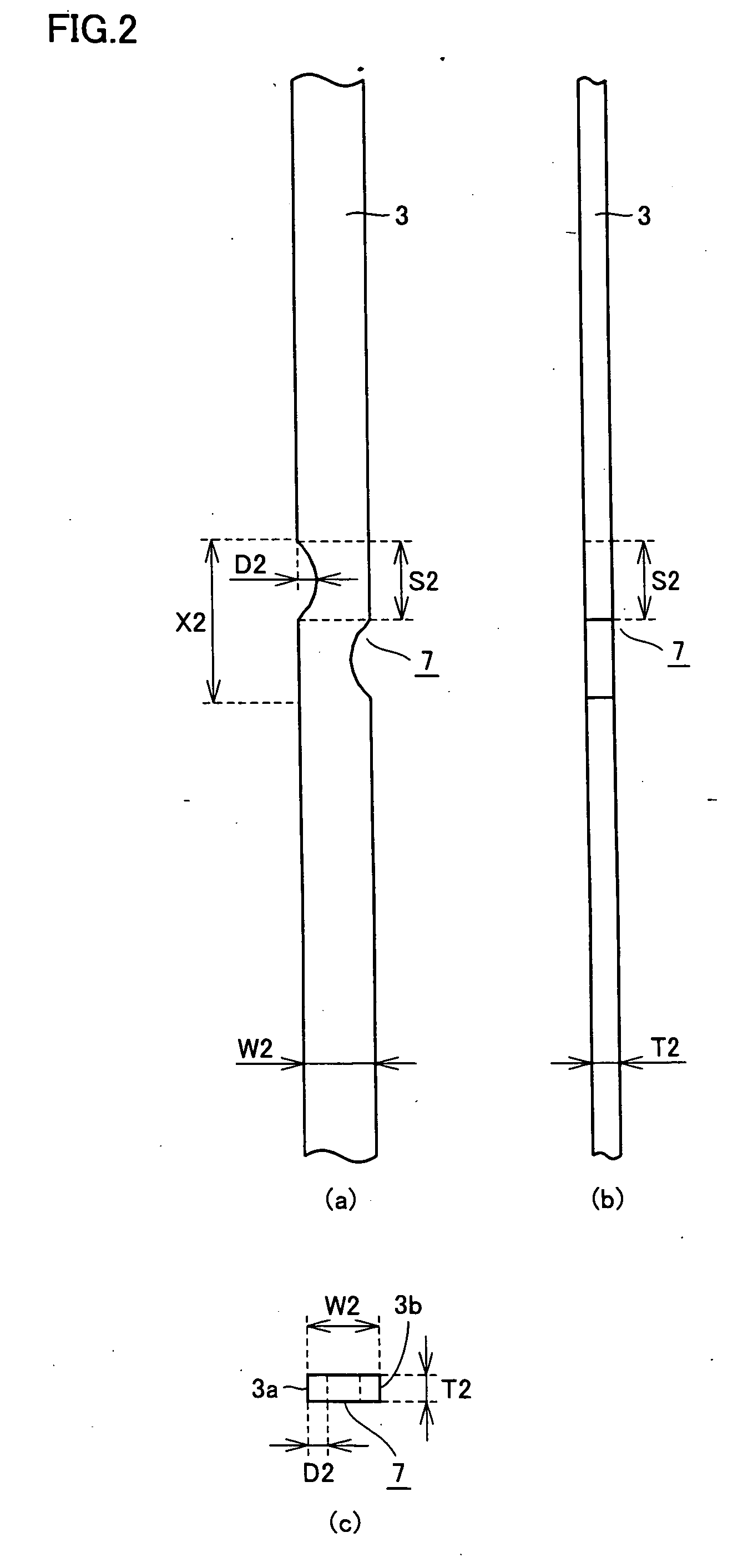Interconnector, Solar Cell String Using the Interconnector and Method of Manufacturing Thereof, and Solar Cell Module, Using The Solar Cell String
a technology of solar cell and interconnector, which is applied in the direction of superimposed coating process, pv power plants, capacitors, etc., can solve the problems of reduced thickness and increased size of silicon wafer, and achieve uniform relief of stress due to a difference in thermal expansion coefficient and improve the reliability of connection between the interconnector and the solar cell. , the effect of reducing the warp occurring to the solar cell
- Summary
- Abstract
- Description
- Claims
- Application Information
AI Technical Summary
Benefits of technology
Problems solved by technology
Method used
Image
Examples
first embodiment
[0087]An interconnector according to a first embodiment of the present invention will be described with reference to FIG. 15.
[0088]FIG. 15 (a) is a plan view showing the interconnector according to the first embodiment of the present invention, FIG. 15 (b) and (c) are diagrams illustrating arrangement of electrodes on a light-receiving surface and a rear surface of solar cells, and FIG. 15 (d) is a diagram illustrating a state where the interconnector shown in FIG. 15 (a) is connected to light-receiving surface electrodes and rear electrodes of the solar cells shown in FIG. 15 (b) and (c).
[0089]Interconnector 1 shown in FIG. 15 (a) is made for example using an electrically conductive member (copper wire) that is solder-plated for example, and has a maximum width W1 (see FIG. 1 (a)) of 2.5 mm and a maximum thickness T1 (see FIG. 1 (c)) of 0.20 mm. As a material for the conductive member, any of other materials such as an alloy of copper-aluminum-copper or copper-Inver-copper may be u...
second embodiment
[0105]An interconnector according to a second embodiment of the present invention will be described with reference to FIG. 16. FIG. 16 (a) is a plan view showing the interconnector according to the second embodiment of the present invention, FIG. 16 (b) and (c) are diagrams illustrating arrangement of electrodes on a light-receiving surface and a rear surface of solar cells, and FIG. 16 (d) is a diagram illustrating the state where the interconnector shown in FIG. 16 (a) is connected to light-receiving surface electrodes and rear electrodes of the solar cells shown in FIG. 16 (b) and (c).
[0106]Interconnector 1 shown in FIG. 16 (a) is made for example using an electrically conductive member 3 such as copper wire that is solder-plated for example, and has a maximum width W1 (see FIG. 1 (a)) of 2.5 mm and a maximum thickness T1 (see FIG. 1 (c)) of 0.20 mm. As a material for the conductive member, any of other materials such as an alloy of copper-aluminum-copper or copper-Inver-copper m...
third embodiment
[0117]An interconnector according to a third embodiment of the present invention will be described with reference to FIG. 17. FIG. 17 (a) is a plan view showing the interconnector according to the third embodiment of the present invention, FIG. 17 (b) and (c) are diagrams illustrating arrangement of electrodes on a light-receiving surface and a rear surface of solar cells, and FIG. 17 (d) is a diagram illustrating the state where the interconnector shown in FIG. 17 (a) is connected to light-receiving surface electrodes and rear electrodes of the solar cells shown in FIG. 17 (b) and (c).
[0118]Interconnector 1 shown in FIG. 17 (a) is made for example using an electrically conductive member (copper wire) 3 that is solder-plated for example, and has a maximum width W1 (see FIG. 1 (a)) of 2.5 mm and a maximum thickness T1 (see FIG. 1 (c)) of 0.20 mm. In the present embodiment as well, as a material for the conductive member, any of other materials such as an alloy of copper-aluminum-copp...
PUM
| Property | Measurement | Unit |
|---|---|---|
| Electrical conductivity | aaaaa | aaaaa |
| Thermal expansion coefficient | aaaaa | aaaaa |
Abstract
Description
Claims
Application Information
 Login to View More
Login to View More - R&D
- Intellectual Property
- Life Sciences
- Materials
- Tech Scout
- Unparalleled Data Quality
- Higher Quality Content
- 60% Fewer Hallucinations
Browse by: Latest US Patents, China's latest patents, Technical Efficacy Thesaurus, Application Domain, Technology Topic, Popular Technical Reports.
© 2025 PatSnap. All rights reserved.Legal|Privacy policy|Modern Slavery Act Transparency Statement|Sitemap|About US| Contact US: help@patsnap.com



